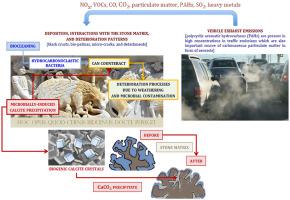当前位置:
X-MOL 学术
›
Int. Biodeterior. Biodegrad.
›
论文详情
Our official English website, www.x-mol.net, welcomes your feedback! (Note: you will need to create a separate account there.)
Bacteria from black crusts on stone monuments can precipitate CaCO3 allowing the development of a new bio-consolidation protocol for ornamental stone
International Biodeterioration & Biodegradation ( IF 4.8 ) Pub Date : 2020-09-01 , DOI: 10.1016/j.ibiod.2020.105031 M. Andreolli , S. Lampis , P. Bernardi , S. Calò , G. Vallini
International Biodeterioration & Biodegradation ( IF 4.8 ) Pub Date : 2020-09-01 , DOI: 10.1016/j.ibiod.2020.105031 M. Andreolli , S. Lampis , P. Bernardi , S. Calò , G. Vallini

|
Abstract The microbial precipitation of CaCO3 is an emerging strategy for the consolidation of decayed limestone. Strains of Bacillus sp. and Micrococcus sp. isolated from black crusts were selected by polycyclic aromatic hydrocarbon enrichment culture and tested for their ability to precipitate CaCO3 by induced mineralization. Among the isolates, Bacillus sp. A2, B1, B5 and Micrococcus sp. A10 produced the largest quantities of biogenic calcite. Stone bio-consolidation was then tested using Carbogel as a carrier. The most efficient bio-cementation on limestone slabs was achieved by Bacillus sp. A2 and B1 and Micrococcus sp. A10. Bio-consolidation treatments were also applied to fragmented stones from the Church of Santa Maria dei Miracoli by inoculating the three bacterial strains individually or as a mixture. Bacillus sp. A2, Micrococcus sp. A10 and the mixture achieved the most efficient consolidation. Our data showed that Carbogel provides an appropriate substitute for natural biofilm formation in bio-consolidation protocols. Scanning electron microscopy and energy-dispersive X-ray spectroscopy revealed calcified bacterial cells filling the pores of stone specimens, increasing the calcium content by 100% more than a non-inoculated control treatment under the same conditions. Our new bio-consolidation protocol therefore provides an effective strategy to prevent the further deterioration of stone monuments.
中文翻译:

来自石碑黑色结皮的细菌可以沉淀 CaCO3,从而为观赏石开发新的生物固结协议
摘要 CaCO3 的微生物沉淀是一种新兴的灰岩固结策略。芽孢杆菌菌株。和微球菌属。通过多环芳烃富集培养选择从黑色结壳中分离出来的,并测试它们通过诱导矿化沉淀 CaCO3 的能力。在分离株中,芽孢杆菌属。A2、B1、B5 和微球菌属。A10 生产的生物方解石数量最多。然后使用 Carbogel 作为载体测试石头生物固结。芽孢杆菌在石灰石板上实现了最有效的生物胶结。A2 和 B1 以及微球菌属。A10. 通过单独或作为混合物接种三种细菌菌株,还对来自圣玛丽亚奇迹教堂的碎石进行了生物固结处理。芽孢杆菌 A2,微球菌属。A10 和混合物实现了最有效的固结。我们的数据表明,Carbogel 为生物固结方案中的天然生物膜形成提供了合适的替代品。扫描电子显微镜和能量色散 X 射线光谱显示钙化细菌细胞填充石头标本的孔隙,在相同条件下,钙含量比未接种的对照处理增加 100%。因此,我们新的生物固结协议提供了一种有效的策略来防止石碑的进一步恶化。扫描电子显微镜和能量色散 X 射线光谱显示钙化细菌细胞填充石头标本的孔隙,在相同条件下,钙含量比未接种的对照处理增加 100%。因此,我们新的生物固结协议提供了一种有效的策略来防止石碑的进一步恶化。扫描电子显微镜和能量色散 X 射线光谱显示钙化细菌细胞填充石头标本的孔隙,在相同条件下,钙含量比未接种的对照处理增加 100%。因此,我们新的生物固结协议提供了一种有效的策略来防止石碑的进一步恶化。
更新日期:2020-09-01
中文翻译:

来自石碑黑色结皮的细菌可以沉淀 CaCO3,从而为观赏石开发新的生物固结协议
摘要 CaCO3 的微生物沉淀是一种新兴的灰岩固结策略。芽孢杆菌菌株。和微球菌属。通过多环芳烃富集培养选择从黑色结壳中分离出来的,并测试它们通过诱导矿化沉淀 CaCO3 的能力。在分离株中,芽孢杆菌属。A2、B1、B5 和微球菌属。A10 生产的生物方解石数量最多。然后使用 Carbogel 作为载体测试石头生物固结。芽孢杆菌在石灰石板上实现了最有效的生物胶结。A2 和 B1 以及微球菌属。A10. 通过单独或作为混合物接种三种细菌菌株,还对来自圣玛丽亚奇迹教堂的碎石进行了生物固结处理。芽孢杆菌 A2,微球菌属。A10 和混合物实现了最有效的固结。我们的数据表明,Carbogel 为生物固结方案中的天然生物膜形成提供了合适的替代品。扫描电子显微镜和能量色散 X 射线光谱显示钙化细菌细胞填充石头标本的孔隙,在相同条件下,钙含量比未接种的对照处理增加 100%。因此,我们新的生物固结协议提供了一种有效的策略来防止石碑的进一步恶化。扫描电子显微镜和能量色散 X 射线光谱显示钙化细菌细胞填充石头标本的孔隙,在相同条件下,钙含量比未接种的对照处理增加 100%。因此,我们新的生物固结协议提供了一种有效的策略来防止石碑的进一步恶化。扫描电子显微镜和能量色散 X 射线光谱显示钙化细菌细胞填充石头标本的孔隙,在相同条件下,钙含量比未接种的对照处理增加 100%。因此,我们新的生物固结协议提供了一种有效的策略来防止石碑的进一步恶化。



























 京公网安备 11010802027423号
京公网安备 11010802027423号